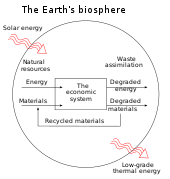
Back الصفقة الجديدة الخضراء Arabic Green New Deal Catalan Green New Deal Czech Y Fargen Newydd Werdd Welsh Green New Deal German Πράσινο New Deal Greek Verda Nova Interkonsento Esperanto Nuevo pacto verde Spanish نیودیل سبز Persian Green New Deal Finnish
| Part of a series about |
| Environmental economics |
|---|
 |
| Part of a series on |
| Ecological economics |
|---|
 |
Green New Deal (GND) proposals call for public policy to address climate change, along with achieving other social aims like job creation, economic growth, and reducing economic inequality.
The name refers to the New Deal, a set of changes and public works projects undertaken by President Franklin D. Roosevelt in 1933-1935 in response to the Great Depression in the United States.[1] The Green New Deal combines Roosevelt's economic approach with modern ideas such as renewable energy and resource efficiency.[2][3] Since the early 2000s, and especially since 2018, proposals for a "Green New Deal" had arisen in Europe, the United States, and other parts of the world.[4][5][6][7]
By the 2009 European Parliament elections, the European Green Party's manifesto was titled, A Green New Deal for Europe, and called for:
a Europe of solidarity that can guarantee its citizens a good quality of life based on economic, social and environmental sustainability; a truly democratic Europe that acts for its citizens and not just narrow industry interests; a Europe that acts for a green future.
[8] The first U.S. politician to run on a Green New Deal platform was Howie Hawkins of the Green Party, when he ran for governor of New York in 2010.[9][10] In her 2012 campaign, Green Party presidential candidate Jill Stein became the first presidential candidate to run on a Green New Deal platform, and has continued to do so in each of her campaigns since then.[11]
A prominent 2019 attempt to get legislation passed for a Green New Deal was sponsored by Rep. Alexandria Ocasio-Cortez (D-NY) and Sen. Ed Markey (D-MA) during the 116th United States Congress, though it failed to advance in the Senate.[12] In the European Union, a 2019 proposal from the European Commission for a European Green Deal was supported by the European Council, and in January 2020, by the European Parliament as well.[13]
- ^ Jeremy Lovell (July 21, 2008) "Climate report calls for green 'New Deal'" Archived June 10, 2020, at the Wayback Machine, Reuters.
- ^ A Green New Deal: Discursive Review and Appraisal. Archived February 24, 2021, at the Wayback Machine Macroeconomics: Aggregative Models eJournal. Social Science Research Network (SSRN). Accessed March 14, 2019.
- ^ Hilary French, Michael Renner and Gary Gardner: Toward a Transatlantic Green New Deal Archived March 29, 2014, at the Wayback Machine The authors state: "Support is growing around the world for an integrated response to the current economic and environmental crises, increasingly referred to as the "Green New Deal". The term is a modern-day variation of the U.S. New Deal, an ambitious effort launched by President Franklin Roosevelt to lift the United States out of the Great Depression. The New Deal of that era entailed a strong government role in economic planning and a series of stimulus packages launched between 1933 and 1938 that created jobs through ambitious governmental programs, including the construction of roads, trails, dams, and schools. Today's Green New Deal proposals are also premised on the importance of decisive governmental action, but incorporate policies to respond to pressing environmental challenges through a new paradigm of sustainable economic progress."
- ^ Harvey, Fiona (September 24, 2019). "Labour's climate policies: what are they and what do they mean?". The Guardian. Archived from the original on November 10, 2019. Retrieved November 11, 2019.
- ^ Yanis Varoufakis and David Adler (April 23, 2019). "It's time for nations to unite around an International Green New Deal". The Guardian. Archived from the original on November 11, 2019. Retrieved November 11, 2019.
- ^ Klein, Naomi (2019). On Fire: The (Burning) Case for a Green New Deal. Allen Lane. pp. 17, 31, 259–293.
- ^ Barbier, Edward (2010). A global green new deal: rethinking the economic recovery. Cambridge; New York: Cambridge University Press. ISBN 978-0-521-76309-7. OCLC 520730520.
- ^ https://www.datocms-assets.com/87481/1698235353-2009_manifesto.pdf
- ^ Robert Harding (July 11, 2020). "Syracuse's Howie Hawkins, a lifelong activist, is Green Party's nominee for president". auburnpub.com/The Citizen. Archived from the original on July 15, 2020. Retrieved July 12, 2020.
- ^ https://progressive.org/latest/where-are-the-greens-in-the-green-new-deal-cobb-190323/
- ^ Robert Schroeder (February 12, 2019). "The 'Green New Deal' isn't really that new". MarketWatch. Archived from the original on April 26, 2019. Retrieved April 16, 2019.
- ^ Rebecca Shabad; Dartunorro Clark (March 26, 2019). "Senate fails to advance Green New Deal as Democrats protest McConnell 'sham vote'". NBC News. Archived from the original on July 15, 2019. Retrieved April 4, 2019.
- ^ Benakis, Theodoros (January 15, 2020). "Parliament supports European Green Deal". European Interest. Archived from the original on December 30, 2020. Retrieved January 20, 2020.